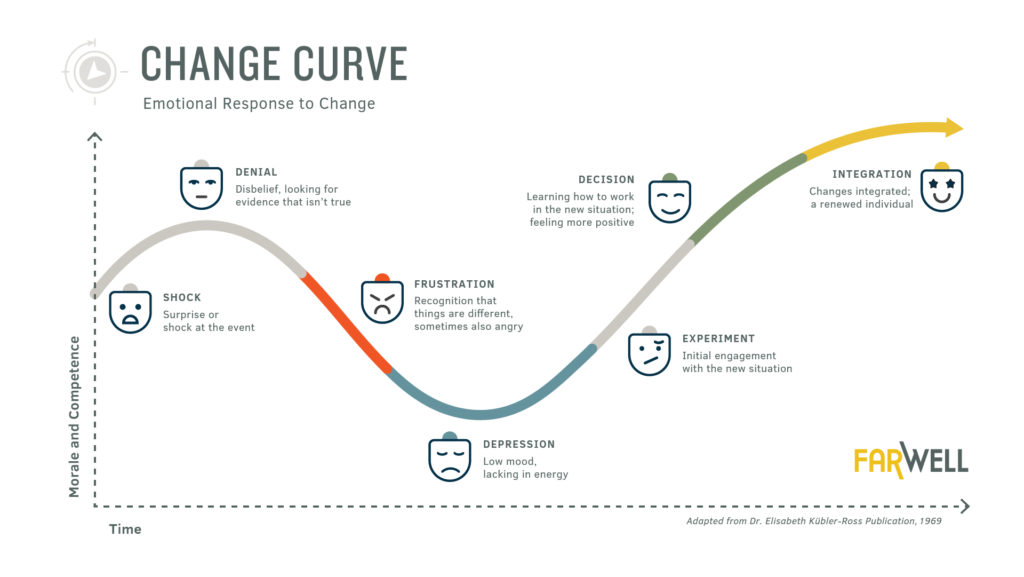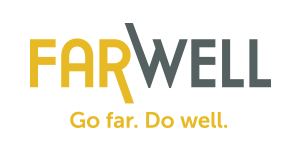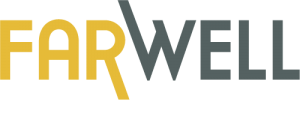Discover advisor articles and other FarWell resources.
Go far. Do well. Call (800) 987-2015
How to Support Leaders and Employees When the New Normal Isn’t Normal

Maintaining Healthy Collaboration and Creativity on Remote Scrum Teams
June 24, 2020
Experience Mapping Webinar for Leaders
August 28, 2020As businesses continue a phased approach to re-opening or transitioning employees back into the office, many have understandably focused their efforts on reducing the risk of COVID-19 transmission and keeping their employees and customers safe. While organizations assess the risks and plan for operational logistics of transitioning back to the office, leaders must be mindful of a key aspect to this transition – supporting employees.
Employees Need More Leadership Support in VUCA (Volatile, Uncertain, Complex, Ambiguous) Work Environments
Employees especially need care and support during this time. They are reeling from massive unrelenting change as a result of VUCA work environments (Volatile, Uncertain, Complex, Ambiguous). In this VUCA environment, employees are expected to adjust to many moving pieces at once.

VUCA is an acronym first documented as a part of the Army War College Library in 1987. The acronym drew on the leadership theories of Warren Bennis and Burt Nanus to describe the volatility, uncertainty, complexity and ambiguity of general conditions and situations.
Source: Who First Originated the Term VUCA | US Army Heritage & Education Center
The impact of VUCA conditions on employee experience:
- Employees must process and adhere to continuously evolving sets of safety guidelines and protocols.
- Changing protocols inside and outside the workplace
- Changing safety guidelines at national and local levels
- Employees are facing natural, mental health effects of isolation and uncertainty like anxiety, and other health impacts like lack of sleep.
This “New Normal” does not feel normal at all to employees and won’t until there is a clear line of sight to how and when this global crisis will end.
How can organizations best prepare and support employees to strengthen their resilience when there is still so much uncertainty about what we think we know, how we should best operate, and what may be next? Here are some ideas for how to provide that much-needed support and structure when employees are experiencing VUCA work environments.
Start with Your Leadership Team
When the work environment is so fluid, leadership teams must constantly engage with and equip each other with information. Leaders are the main line of support for employees. Giving leaders what they need to feel more prepared and confident in supporting their teams builds organizational resilience. Ways to support leaders during VUCA conditions:
Name the ambiguity.
Reinforce with leaders that managing ambiguity is going to be the norm for awhile. They won’t always have all of the answers for their teams; instead, they should commit to sharing what they know, when they know it and live up to that commitment.
Give leaders a heads up to employee changes.
Provide leaders as much advance notice as feasible of any changes to expectations before sending them to all employees (even if it is just an hour or two in advance). This early awareness provides an opportunity for leaders to absorb and prepare for employee questions or possibly even proactively reach out.
Create support for compliance.
Given evolving sets of new rules and requirements for employees, communicate the expectations for enforcement and what support leaders will have to address team members who are not adhering to the new expectations.
Consolidate resources and make them accessible.
Continually remind leaders where they – and their teams – can find resources with the latest information. Identifying a spot on the corporate intranet site is essential along with posting visual reminders throughout the office. Provide a designated email or chat group that leaders can reach out to for immediate support when an employee question arises to which they can’t find the answer.
Use the buddy system.
Identify back-to-work buddies so leaders can regularly connect with peers to share common challenges and discuss how each is addressing those challenges.
The “Normal” of Today May Change Tomorrow. Educate and Equip Employees So They Know How to Stay Informed.
To ensure their own and others’ safety as employees transition back to the office, they need to make changes immediately. This shift is difficult without thoughtful and ongoing change support.
Start by increasing your frequency of employee engagement.
Ask your leaders to increase the frequency of their regularly scheduled check-ins with each of their team members to share updates and give them the opportunity to ask questions. These don’t have to be long or formal. A chat or email may be all that is needed, but checking in needs to happen more frequently, especially if employees are not all back in the office together.

Centralize and organize information.
To help employees find the latest expectations, training, resources and processes to better understand what is changing or staying the same and where they can get support, set up an online tool that all employees can easily access. The intent of the tool is to provide a one-stop resource so employees have confidence that they can get the latest updates without constantly going back through emails or having to remember conversations on what they need to do differently. The tool should be available via a computer or personal device (e.g. cell phone) to provide additional accessibility options.
In addition, organizing the myriad of information into topic areas aids employees in being able to easily find what they need.
Example pandemic reference topics and related material to include in your one-stop platform:
- Employee Return Timeline Documentation and Process Training
- Personal Protective Equipment (PPE) Expectations, Training and Supplier Documentation (e.g. masks)
- Employee COVID-19 Screening, Reporting and Tracking Protocols
- Organizational & Employee Cleaning Practice Documentation
- Disinfection Protocols
- Work Area Adjustment (Communication including desk area, common areas, meeting rooms, and other crowd control limitations)
- Employee Compliance / Enforcement Expectations
- Procedures for Personal Considerations (e.g. support to parents if schools/daycares are not open)
- Individual Resilience Capability-Building Training
Having a reliable online common access point for the latest updates on the above will help reduce some of the volatility and ambiguity that employees feel, and make the complex feel simpler.
Note: With so much in flux, having this one-stop online platform is key to sharing information, but realize that it will not be enough. Given the many topics upon which to provide additional training and communication during a pandemic crisis, multiple channels will need to be used like town halls, one-on-ones, blogs, etc. to make sure the latest information is being received by the audience.
Share the responsibility.
We’ve heard frequently that “we’re in this together” and that phrase especially applies to entering the new normal.
Communication about the transition back and what it means can’t just be one-way from leaders to employees. Clearly and simply set the stage that employees share in the responsibility for proactively reaching out, connecting with their leaders and colleagues, and providing updates on how they are faring. During this particular VUCA period, fostering feedback loops is paramount, especially when there are still members of the workforce that are remote, and there are not as many opportunities to physically touch base and read non-verbal cues.
As previously stated, organizations should do their part by asking leaders to schedule more frequent check-ins with employees individually and in teams. Include opportunities for employees to share how they are feeling and responding. Less frequent touch bases may have been sufficient when it was business as usual and everyone was together in a physical office, but not in a VUCA environment.

Focus on employees’ wellness and mental health.
Though many transition plans focus on employee physical health, supporting employee mental health is also critical. Many are feeling more anxious and isolated. Leaders should consistently ask questions like “How are you doing?” or “What can I do to help you?” to show that they care about more than just the employee’s productivity or outcomes.
Also remind employees of resources where they can access mental health support:
- Your organization’s Employee Assistance Programs (EAPs) or health plans
- SAMHSA (Substance Abuse and Mental Health Services Administration)
- 24/7 Disaster Distress Helpline @ 1-800-985-5990
- NAMI (National Alliance on Mental Illness) Helpline at 1-800-950-NAMI (6264) or info@nami.org.
- National Suicide Prevention Lifeline 800-273-8255
In times of crisis, opportunities are plentiful for leaders to either build or weaken trust with employees. In this VUCA environment when some are in the midst of transitioning back to the office, we must keep employees top of mind. Remind leaders at all levels to practice servant leadership—show empathy, remain calm, listen and be as flexible as possible.
Transition Back with a Strategic Employee Plan
We’re all in the same boat trying to find the elusive “New Normal” or something on which to to ground ourselves. Through supporting leaders, equipping employees, sharing responsibility, and focusing on employees’ mental and emotional health, organizations can reinforce their commitment to their people. Organizations can develop a culture of resilience even when there may not be a sense of “Normal” for a while.
FarWell is here to help companies navigate complex change, especially now, during VUCA conditions. Advisory teams collaborate with your organization. Together we plan and strategize what critical steps are needed to sustain and develop your business processes and culture in evolving work environments. FarWell partners with your stakeholders to develop an Agile approach and will roll up their sleeves to help execute. If you’re experiencing volatile, complex and ambiguous conditions with employee uncertainty in your re-entrance strategy, we can help!
For more expert guidance on navigating organizational change, read FarWell’s article on using the Change Curve to lead with understanding, empathy, and awareness during times of upheaval. You can also share the Change Curve with your colleagues.





